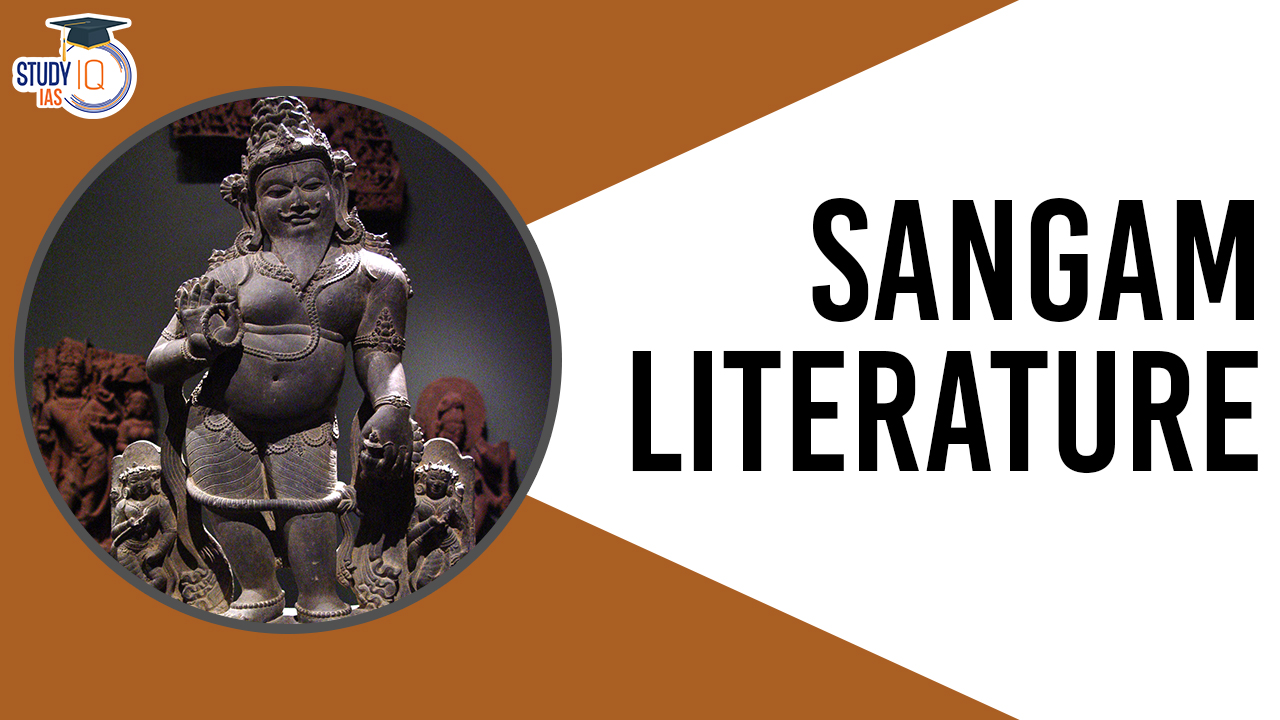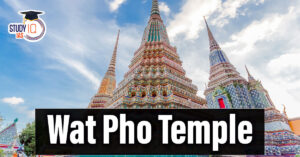Table of Contents
Sangam Literature
Sangam Literature, also known as “the poetry of the noble ones,” refers to the ancient Tamil language and is the earliest known literature from South India. The oldest available Tamil literature is Sangam literature. The Sangam Period is roughly between 300 BC and 300 AD, with the majority of the work produced between 100 CE and 250 CE. This article will explain the Sangam Literature, which will be useful in preparing for the important Ancient History section of the UPSC Syllabus.
We’re now on WhatsApp. Click to Join
Sangam Literature History
Sangam literally translates to ‘association.’ It is a term that describes a group of Tamil poets who flourished in ancient southern India. The Ancient Tamil Siddhar Agastyar is thought to have presided over the first Tamil Sangam at Madurai from the first to fourth centuries CE. Sangam texts are unusual in early Indian literature, which is almost entirely religious.
Sangam Literature was contributed by 473 poets, 102 of whom were anonymous. The poets came from a variety of backgrounds, including royalty, businessmen, and farmers. Women made up at least 27 of the poets. These poets emerged in a context in which Tamil (Dravidian) civilization had previously engaged and inextricably fused with north Indians (Indo-Aryans), and both sides shared mythology, morals, and literary norms.
Many of the poems, particularly those about heroism, have a great deal of freshness and vitality and are strikingly devoid of the literary conceits that pervade most of India’s other early and mediaeval literature. They deal almost entirely with nonreligious issues, and they lack the rich legendary references that distinguish most Indian art forms. Nonetheless, religious compositions can be found in Sangam poetry. Poems about Vishnu, Shiva, Durga, and Murugan, for example, may be found in Sangam Literature.
Sangam Literature Classification
Sangam literature is classified into two types: akam and puram. Emotions and sentiments in the context of romantic love, sexual connection, and sensuality are central to Akam poetry. Puram poetry is concerned with exploits and heroic achievements in battle and public life settings. Three-fourths of Sangam poetry is akam-themed, with the remaining one-fourth puram-themed.
Sangam literature is divided into seven minor genres known as tinai, which include akam and puram. This minor genre focuses on the poetry’s setting or scenery. Kurinci denotes mountainous regions, mullai pastoral woods, marutam riverine agricultural land, neytal coastal regions, and palai arid regions.
For akam poetry, in addition to landscape-based tinais, ain-tinai (well-matched, mutual love), kaikilai (ill-matched, one-sided), and perunthinai (unsuited, big genre) categories are used. An example of reciprocal love poetry is the Ainkurunuru, a collection of 500 short poems. Vetchi (cattle raid), vanchi (invasion, preparation for war), kanchi (tragedy), ulinai (siege), tumpai (battle), vakai (victory), paataan (elegy and acclaim), karanthai, and pothuval are examples of tinais used in puram poetry.
The akam poetry uses metaphors and images to create atmosphere; it never contains names of people or places, and it frequently omits context, which the community would fill in and understand given their oral history. Puram poetry is more direct, employing names and locations.
Sangam Literature Major Works
The period of Sangam literature is still debated because the three major epics of the time, Silappathigaram, Dipavamsa, and Mahavamsa, show that Gajabhagu II of Sri Lanka and Cheran Senguttuvan of the Chera dynasty were contemporaries. In addition, coins struck by the Roman Emperor in the first century can be found in large quantities in various parts of Tamil Nadu.
Furthermore, Greek authors like Megasthenes, Strabo, and Pliny claimed trade routes between the West and South India. Inscriptions from the Ashokan Empire described the Cheras, Chola, and Pandya monarchs to the south of the Mauryan Empire. The Sangam literature has been dated between the third century B.C. and the third century A.D. based on literary, archaeological, and foreign evidence.
Tolkappiyam, Ettutogai, Pattuppattu, Pathinenkilkanakku, and the two epics Silappathikaram and Manimegalai are among the Sangam literature. During the postmodern era, Elango Adigal’s Silappathigaram and Sittalai Sattanar’s Manimegalai were both published. These works contain critical information about the Sangam political system and society.
The Kalugumalai inscription contains information about Tamil Brahmi writing from the 15th century. The Tirukkovalur inscription mentions both local chieftains and the tragic fate of Tamil poets. The first of these works, written by Tolkappiyar, contains information about the social, economic, and political situations of the Sangam Age, as well as Tamil grammar. The eight Anthologies, each with eight pieces, were Ettutogai. Ettutogai and Pattuppattu were divided into two major groups: Aham (love) and Puram (valour).
Silappathikaram
Silappatikaram is the first Tamil epic. It’s a 5,730-line poem almost entirely written in akaval (aciriyam) metre. In Tamil tradition, Ilango Adigal is credited with creating Silappatikaram. He is said to be a Jain monk and the younger brother of Chera king Senguttuvan, the family and rule of whom is described in the Fifth Ten of the Patiuppattu, a Sangam poem.
The epic’s protagonists are Kannaki and her husband Kovalan, who tell the sad love story of an ordinary couple. Kannaki and other characters from the story appear in Sangam literature such as the Naiai and later works such as the Kovalam Katai, implying that the Silappathikaram has deeper roots in the Tamil bardic tradition. It is said to have been written by Iak Aika, a prince-turned-monk, in the 5th or 6th century CE.
Manimegalai
Manimekalai, also known as Manimekhalai or Manimekalai, is a Tamil-Buddhist epic written most likely in the sixth century by Kulavika Seethalai Sataar. It’s a “anti-love narrative,” a sequel to the “love story” in the first Tamil epic Silappadikaram, with some of the same characters and descendants. The epic is divided into 30 cantos and has 4,861 akaval lines. Manimekalai is also the name of Kovalan and Madhavi’s daughter, who is a Buddhist nun and dancer like her mother. The story is told in epic manner.
Tolkappiyam
Tolkappiyam is the oldest extant Tamil grammar text as well as the oldest extant lengthy work of Tamil literature. Some believe Tholkapiyam was written by a single author named Tholkappiyar, a disciple of the Rigvedic sage Agastya. In the extant manuscripts, the Tolkappiyam is divided into three volumes (athikaram), each with nine chapters (iyal), for a total of 1,610 sutras in the nurpa metre.
This comprehensive grammar work includes sutras on spelling, phonology, etymology, morphology, semantics, prosody, sentence structure, and the importance of context in language. It is impossible to date the Tolkappiyam. According to some Tamil scholars, the passage is from the mythological second sangam, which dates from the first millennium BCE or earlier.
Ettuthogai
The Eight Anthologies, also known as Ettuttokai or “Eight Collections,” is a great Tamil literary work that is part of the Eighteen Greater Texts (Patinen-melkanakku) anthology series published by Sangam Literature. The earliest Tamil works are the Eight Anthologies (Pattuppattu) and its companion anthology, the Ten Idylls (Pattuppattu). Ettuthogai consists of eight works: Aingurunooru, Narrinai, Aganaooru, Purananooru, Kuruntogai, Kalittogai, Paripadal, and Padirruppatu (Eight Anthologies).
Pattuppattu
The Ten Idylls, also known as Pattupattu or Ten Lays, is a collection of ten longer poems from the Sangam period of Tamil literature. They range in length from 100 to 800 lines, and the collection includes Nakkirar’s well-known Tirumurukarruppaai. The Pattupattu collection dates from the second to third centuries CE, the middle layer from the second to fourth centuries CE, and the last layer from the third to fifth centuries CE.
The Pattupattu (Ten Idylls) consists of ten works: Thirumurugarruppadai, Porunarruppadai, Sirupanarruppadai, Perumpanarruppadai, Mullaippattu, Nedunalvadai, Madurai Kanji, Kurinjippatttu, Pattinappalai, and Malaipadukadam.
Pathinenkilkanakku
The Pathinenkilkanakku, also known as the Eighteen Lesser Texts in literature, is a collection of eighteen poetry compositions, the majority of which were composed after the Sangam period (between 100 and 500 CE). Pathinenkilkanakku contains eighteen texts on ethics and morality. The most important of these texts is Tirukkural, written by Thiruvalluvar, a well-known Tamil poet and philosopher.
The poems in this collection differ from those in the Eighteen Greater Texts, the oldest known Tamil poetry collection, in that they are written in venpa metre and are very brief. Naladiyar, a single anthology in this collection, has been sung by 400 poets.
Sangam Literature Significance
There were three major Tamil kingdoms during this time period: the Cheras, the Cholas, and the Pandyas. The Sangam literature documents the indigenous literary growth in South India parallel to Sanskrit, as well as the classical rank of Tamil. While there is little evidence for the first and second mythological Sangams, the surviving literature attests to a group of intellectuals based in ancient Madurai (Maturai) who influenced the “literary, academic, cultural, and linguistic life of ancient Tamil Nadu.”
The Sangam literature reveals details about ancient Tamil society, secular and religious ideas, and individuals. Sanskrit loan words are found in the Sangam literature, implying ongoing linguistic and literary collaboration between ancient Tamil Nadu and other areas of the Indian subcontinent. Sangam poetry is about culture and people. Except for the occasional reference to Hindu gods and more significant allusions to numerous gods in the shorter poems, it is almost entirely non-religious.
Sangam Literature UPSC
Sangam is a Sanskrit word that means “association.” It refers to Tamil Sangam, a Tamil poets’ organisation in ancient South India. From the first to fourth centuries CE, the Ancient Tamil Siddhar Agastyar is thought to have presided over the first Tamil Sangam in Madurai. Sangam’s writings are possibly unique in early Indian literature, which is almost entirely religious in nature. This article has all the details related to Sangam Literature, for more details related to the UPSC Examination; students can visit the official website of StudyIQ UPSC Online Coaching.
| Other Important Articles | |
| Tripartite Struggle | Maurya Empire |
| Gupta Empire | Rig Vedic Period |
| Rashtrakuta Dynasty | Later Vedic Period |


 Jallianwala Bagh Massacre, Date, History...
Jallianwala Bagh Massacre, Date, History...
 Chittorgarh Fort: Mining Ban within 10 k...
Chittorgarh Fort: Mining Ban within 10 k...
 PM Modi visits Wat Pho Temple in Bangkok
PM Modi visits Wat Pho Temple in Bangkok





















